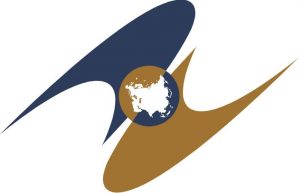On Friday, May 27, the heads of the Eurasian Economic Union (EAEU) member-states are scheduled to meet, with the first Eurasian Economic Forum planned for the day before in Bishkek, the capital of Kyrgyzstan. Russia’s invasion of Ukraine in late February, the ongoing war, the resulting sanctions, and the ensuing economic fallout have exposed cracks between the members.
The EAEU, which includes as members Armenia, Belarus, Kazakhstan, Kyrgyzstan, and Russia is widely viewed as a Moscow-led bloc. Of the EAEU’s 10 largest cities, for example, eight are in Russia. Russia’s economy dwarfs those of the other members, most of which rely in one way or another on the Russian economy. In 2020 figures, Russia’s GDP stood at $41.5 trillion; the closest EAEU economy was Kazakhstan at $170 billion.
Although Kyrgyzstan is hosting this year’s summit of the Supreme Eurasian Economic Council and the forum, it will be largely a digital affair. According to the state-owned Belarusian news agency Belta, Chairman of the Board of the Eurasian Economic Commission Mikhail Myasnikovich said last week that they were planning on an in-person summit, but it was decided the leaders would attend via video-conference instead.
On May 20, however, 24.kg reported Kyrgyz Deputy Chairman of the Cabinet of Ministers Arzybek Kozhoshev as saying that Kazakh President Kassym-Jomart Tokayev would be attending in person. This will present some interesting optics, with Kyrgyz President Sadyr Japarov and Tokayev together in a room and the other three presidents on screens. (Update: Apparently, although Tokayev is in Bishkek, he will also participate virtually, too). Of course, it’s a shorter trip to Bishkek for Tokayev from Nur-Sultan than for Russian President Vladimir Putin from Moscow, but logistics aren’t the reason Putin isn’t taking the trip.
Putin has hosted a limited number of foreign leaders since the invasion of Ukraine began on February 24 (in fact, he was hosting then-Pakistani Prime Minister Imran Khan as the war began), but he had not traveled abroad himself since an early February trip to China for the opening ceremonies of the Beijing Winter Olympic Games. The leaders of Kazakhstan, Kyrgyzstan, and Tajikistan were in Moscow on May 16 for a Collective Treaty Security Organization (CSTO) meeting.
The EAEU is ostensibly a vehicle for economic integration, having come into force in January 2015, with Kyrgyzstan joining later that year. As the organization puts it: “The EAEU provides for free movement of goods, services, capital and labor, pursues coordinated, harmonized and single policy in the sectors determined by the Treaty and international agreements within the Union.”
In practice, the “free movement” of goods and labor have occasionally been impeded by bilateral snafus.
Traffic at the Kazakhstan-Kyrgyzstan border, for example, has been stopped at various times in the past seven years. In 2017, after then-Kyrgyz President Almazbek Atambayev criticized then-Kazakh President Nursultan Nazarbayev, Kazakh authorities stepped up border controls and inspections, slowing traffic at the border considerably; similarly in 2019, trucks stretched along the Kyrgyz roads to the border for several weeks.
The EAEU members’ current economic troubles will further stress the union’s cohesion, as will potentially widening political gaps.
Russia has been targeted by several rounds of sanctions, including being cut out of the SWIFT international payment system, which enables the smooth transfer of funds across borders. This will invariably have secondary effects on the members of EAEU countries for whom greater, presumably smoother, access to the Russian market were benefits of membership. The Russian market just isn’t what it used to be. At the same time, the cratering of the Russian economy, and the difficulty of Russian businesses in engaging with the world, has presented opportunities. Kazakhstan, for example, has stated openly that it’s happy to host Russian businesses looking to relocate.
Although Belarus has placed itself firmly on Russia’s side, as the Ukraine conflict divided the world into polarized camps the rest of the EAEU’s members landed somewhere in the gap. When the U.N. General Assembly voted on a resolution in early March condemning the Russian invasion, Armenia, Kyrgyzstan, and Kazakhstan all abstained.
Kazakhstan, as noted above, has seized the economic opportunities presented by the Russian economy’s troubles. Nur-Sultan has also promised Europe that it would not help Russia evade sanctions (though it stopped short of joining those sanctions). And most recently, it seems a plant in northern Kazakhstan that had long supplied the majority of iron ore for a steelworks operation in Magnitogorsk, Russia, stopped shipments. As Joanna Lillis explained for Eurasianet, the chairman and majority stakeholder in the steelworks, Viktor Rashnikov, is one of the Russian oligarchs under sanction.
Where this leaves the EAEU is unclear. If the EAEU is simply an economic project, the current circumstances will strain its relevance. Uzbekistan and Tajikistan, which have entertained in varying degrees the idea of membership, seem unlikely to push for it now, and certainly not while the Russian economy is so toxic. If the EAEU is, as some analysts over the years have suggested, the opening move in a neo-Soviet project in the mind of Putin, the current circumstances show its limitations. Can the union survive the choices made by Putin? Only time will tell.

































